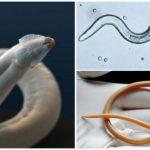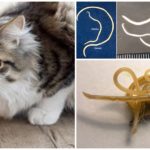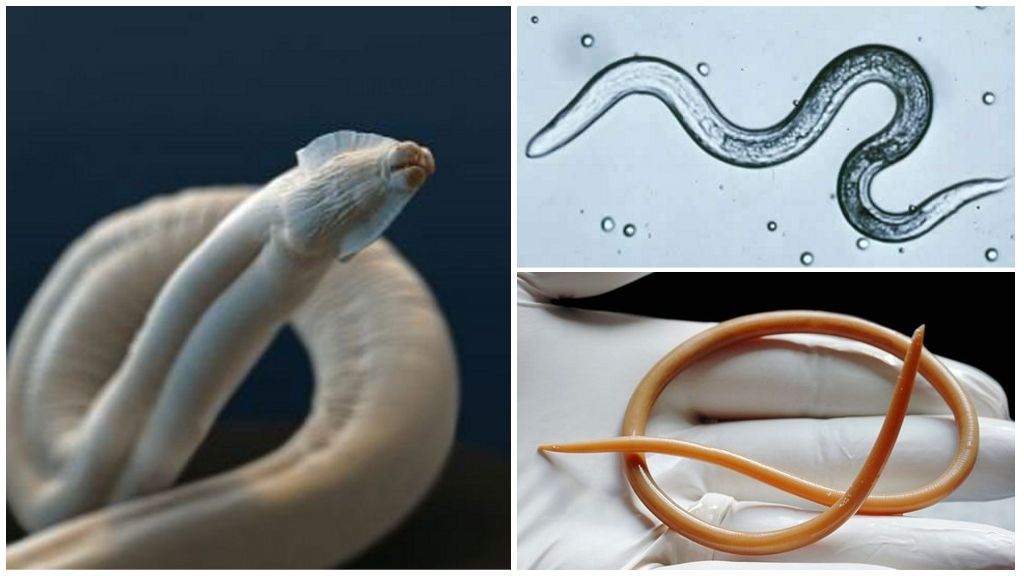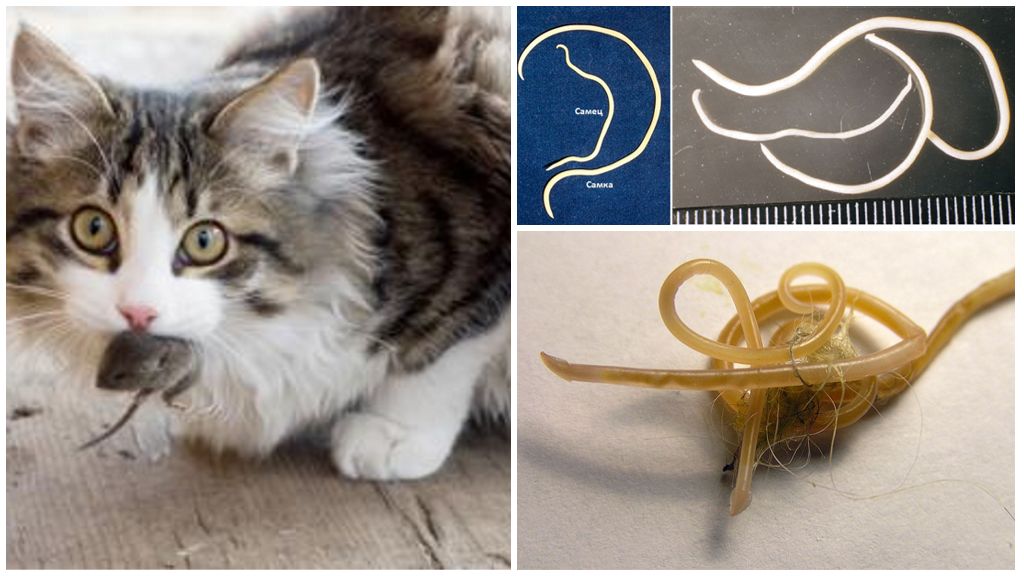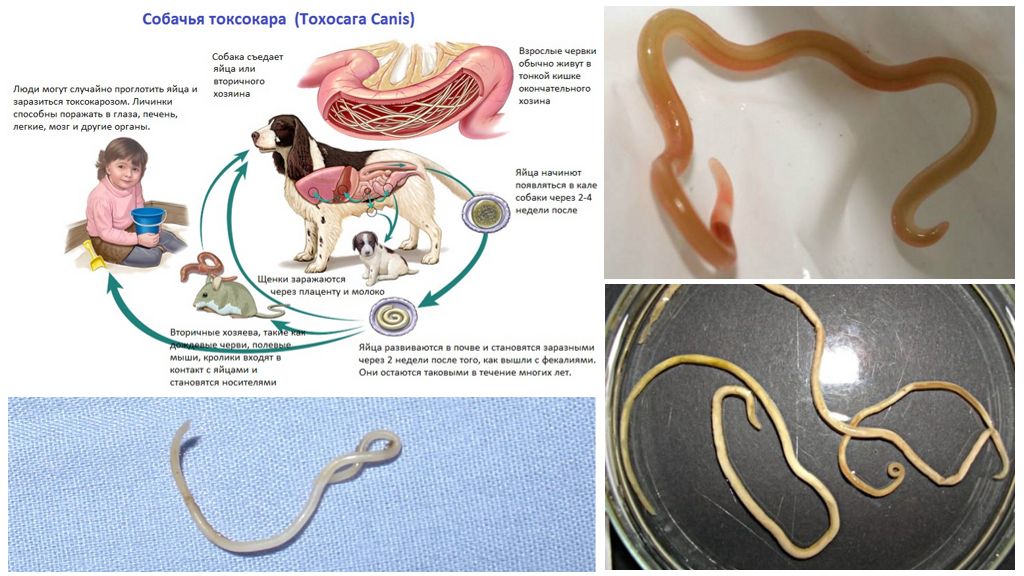Description and photo toksokar
Content
- Canine Ascaris or Toxocara Canis
- Cat Toxocara
- Tokocar life cycle
Toxocars are helminths that are a type of roundworm. Getting into the human body, these parasites cause disease toksokaroz. Among them, the danger to humans are dog and cat. Helminth is parasitic and develops in the body of dogs and cats, from which it falls to humans.Representatives of toxocar, Giardia, roundworm and other parasitic worms are capable of causing little harm to the human body with little symptoms. That is why you should know their features and ways of entering the body and be able to prevent infection.
Who are toxocars
The morphology of toxocar depends on which species it belongs to. But there are some common points. Canine is more common and therefore occurs in humans more often than the cat.
On a note!
Toxocarosis is more pronounced in large cities, since the number of homeless animals suffering from helminthic invasions has increased.
Canine
Canine roundworm or toxocara kanis reaches a length of 9 to 18 cm. The parasite has cuticular wings. They protrude above its body arc and are a distinctive feature of the structure of the toxcar of this species, as well as the "ventricle", which can be detected at the end of the esophagus and before the beginning of the intestine.
In the photo toksokar one can see that their color is greyish yellow. The male has a curved end of the body, located behind. The reproductive system consists of two spicules, which are extensible organs and a testicle of the tubular type.The female's reproductive system is represented by the vulva, which is one third of the entire body length. Dog toxocar eggs are dark gray and rounded. Their structure is cellular.
Important!
An adult worm lives for about six months and lays more than 200 thousand eggs a day, which, once in the ground, retain their invasiveness for up to 10 years.
Cat
Sizes of toxocar parasitic in cats range from 3 to 10 cm. The female is larger than the males. A distinctive feature of the male individual is a curved back end. In the head area of a mature individual, wings of the cervical type are located. The helminths of toxocar of this species are round-shaped eggs, which have a brown color and a thick shell with a rough surface.
Both species in their mature form have a formed digestive system and an oral opening surrounded by three lips.
Tokocar life cycle
The development cycle of toxocar does not always occur according to the same scenario. And toksokar larvae can be in different hosts. There are both similarities and differences in different types of worms. Eggs released from the host are not immediately invasive.In the environment, they must mature for several weeks.
On a note!
Only a ripe egg can trigger the development of toxocariasis.
The development of dog parasites
There are 4 ways of development of the dog toksokar larvae. Begin any of them equally. Together with the faeces of an infected dog, tokocar eggs enter the environment, which after a couple of weeks turn into ripe and infectious. Once in the dog's body, the shell of the egg releases the toxocar larva, the latter penetrates through the intestinal wall into the blood vessels of the circulatory system. Below are options for the development of the toxocar worm.
- The main way. This option is typical for dogs no older than three years. The larvae are carried by blood to the liver and lungs, through the trachea in the dog’s mouth and swallowed back into the small intestine, where they mature.
- Infection of puppies in utero. At representatives of the dog, whose age exceeds 3 years, worms do not move. They settle and grow into a capsule in different organs. During pregnancy, they are activated and enter the body of puppies through the umbilical veins. Infection of all offspring is possible.
- Infection from the mother through breast milk.
- Infection through an intermediate host (mouse or rabbit).
On a note!
Once in the human body, parasites come to a dead end path of their development.
Cycle cat litter
The final owner for tokocar cats are cats, but the intermediate can be mice, earthworms and even cockroaches, as well as humans. In none of the possible hosts, the helminth does not develop into a mature individual.
The cat swallows the tokocar eggs and a larva leaves it, which has already passed two of its four molts inside the egg. From the intestines of toxocar penetrates the circulatory system and spreads through the body. Like a dog toxocare, it reaches the mouth of the animal and is swallowed. Further, all development and reproduction occurs in the small intestine.
Important!
Toxocar parasites can be transmitted with breast milk to newborn kittens, but unlike the Kanis species, the larvae do not penetrate the placenta and do not infect the offspring in utero.
Prevalence of the parasite
Any of the causative agents of toxocarosis is widespread.In large cities, the number of cases is much greater.
What are dangerous to humans?
A person becomes infected with toxocar parasites upon contact with stray animals or animals not undergoing anthelmintic treatment. Infection can also occur when using unwashed plant products that have received toxocar eggs. These routes of infection are the most frequent. There are other options. It may also be an open wound contact with the soil.
Important!
Eggs of pathogens can be on any surface. They are spread everywhere by flies and cockroaches.
But even without such carriers, people are able to infect themselves. Small children often pull dirty objects into their mouths and even the ground itself. All this increases the risk of infection many times. Another route of infection for humans is by eating rabbit, sheep or chicken meat, which were infected with parasites. Liver and other by-products are especially dangerous in this regard.
Eggs enter the body and pass into the larval stage in the intestine, after which they are introduced into the blood vessels. The distribution of larvae occurs throughout the body, where cysts are formed from them in different tissues. This happens due to the fact that the larvae are covered with a shell.Toxocarosis can be ocular or visceral. This will depend on where the pathogens are located. The disease is poorly manifested and is treated for a long time. Therapeutic activities may last for several months.

